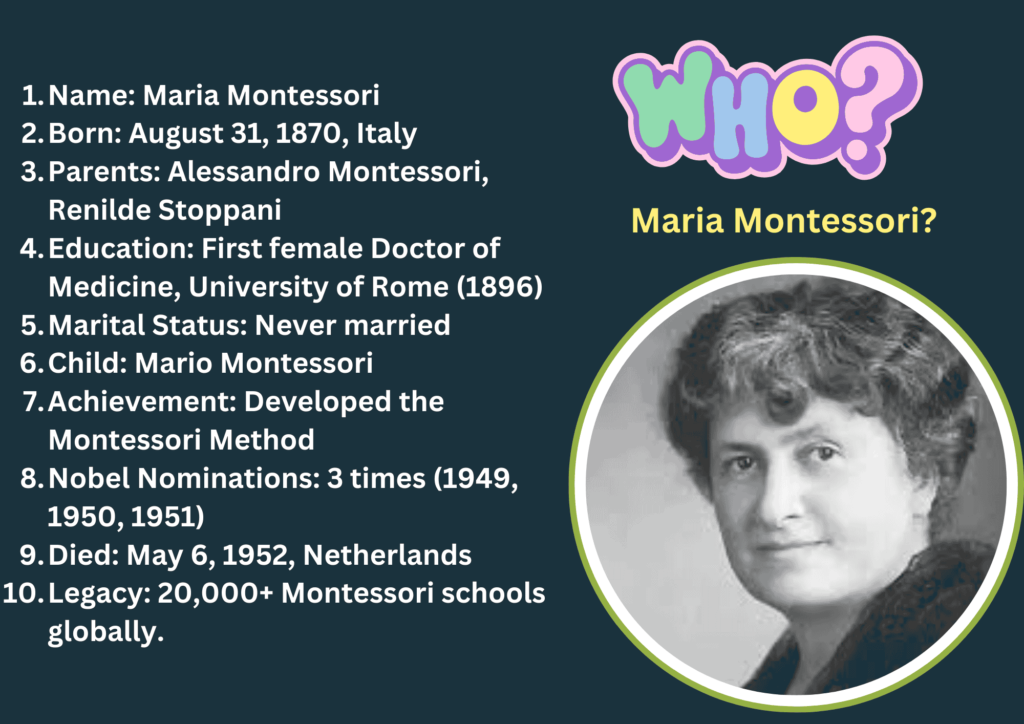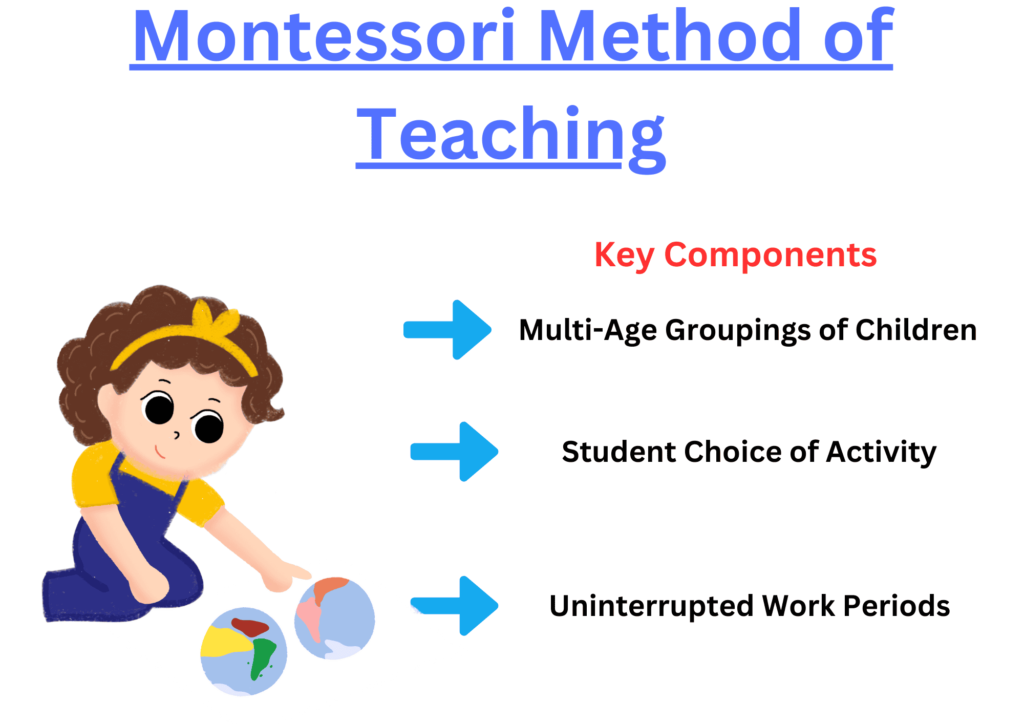The Montessori method of teaching is a distinctive educational approach (methods) that focuses on:
- Child-led learning (children guiding their own learning)
- Self-discovery (learning through exploration)
This method has been successfully integrated into numerous private and public school curricula. At its core it remains a philosophy deeply rooted in promoting a child’s holistic development—socially, emotionally, physically plus and academically. In this article, we will explore the Montessori method of teaching pdf (download file in pdf form) by looking at:
- Its core components
- Key principles
- The significant role it plays in fostering a love for learning in children
- Scroll Down You Can Also Download the Montessori Method of Teaching Pdf.

Table of Contents
ToggleWhat is Montessori?
The Montessori method of teaching is a scientifically (research-based) founded educational approach that emphasizes the natural development of children. Developed by Dr. Maria Montessori an Italian physician and educator, this method believes that children have an innate potential for learning and growth. The Montessori approach nurtures a child’s natural curiosity or meddlesomeness, allowing them to explore and learn at their own pace.
- Word Origin: The term “Montessori” is derived from the name of Dr. Maria Montessori. The word itself doesn’t have a specific meaning outside of her name, but it represents an educational approach centered on child-led learning and development.
In a true Montessori environment education is not just about academic achievement. It is about developing a childs:
- Social abilities (skills to interact with others)
- Emotional growth (development of emotional intelligence)
- Physical development (growth and physical coordination)
Montessori schools, whether private or public, aim to create environments that encourage children to become independent, self-motivated learners who are capable of thinking critically and creatively.

Key Components of Montessori Teaching
The Montessori method of teaching includes several essential components that set it apart from traditional educational approaches:
Multi-Age Groupings of Children
Montessori classrooms often mix children of different ages. This allows younger students to learn from older peers, while older students reinforce their knowledge by teaching younger ones. This interaction mirrors real-world social dynamics and helps build a sense of community and cooperation (working together).
Student Choice of Activity
Children in a Montessori classroom have the freedom to choose their activities from a range of hands-on learning materials. This autonomy (freedom) fosters responsibility and independence. Teachers act as guides, selecting activities that match each child’s developmental stage and interests.
Uninterrupted Work Periods
Unlike traditional classrooms with short periods for different subjects, Montessori classrooms provide uninterrupted blocks of time (typically two to three hours) for children to deeply engage in their chosen activities. This approach promotes concentration and mastery (deep understanding) of concepts.
Core Principles of Montessori Education
The Montessori method is built on several core principles that shape the learning experience:
Child-Directed Work
Children are encouraged to take charge of their learning by choosing activities that interest them. They can spend as much time as needed to explore and master concepts, fostering deep engagement and satisfaction in learning.
The Absorbent Mind
The Montessori method acknowledges that young children have an “absorbent mind,” which allows them to naturally absorb information from their environment. This principle is most evident during the toddler years, making it an ideal time to introduce the Montessori approach.
Sensitive Periods for Learning
Montessori educators understand that children go through specific “sensitive periods” (times when they are particularly receptive to learning certain skills). Teachers tailor their instruction to these periods, ensuring children receive the most effective learning experience.
The Prepared Environment
A hallmark (distinctive feature) of the Montessori method is the carefully prepared classroom environment. In a Montessori classroom, everything is designed to facilitate independent learning and exploration. The materials are arranged to:
- Encourage discovery (promote exploration)
- Promote hands-on interaction (encourage learning by doing)
- Be child-friendly with appropriately sized furniture and tools
This environment allows children to feel comfortable and confident as they navigate their learning journey.
Independence and Discovery
One of the fundamental goals of the Montessori method is to foster independence and a love of discovery in children. Teachers observe each child’s interests and readiness, developing activities that align with their individual needs. This approach not only promotes academic growth but also builds:
- Self-esteem (confidence in one’s abilities)
- Creativity (ability to think outside the box)
- A lifelong love of learning
The Role of the Montessori Teacher
In the Montessori method the teachers role differs from that in traditional classrooms. Montessori teachers are not lecturers but rather:
- Guides or facilitators (helping rather than leading)
- Preparers of the learning environment (setting up the classroom to promote learning)
- Presenters of activities (showing children how to use materials)
They step back to allow children to explore on their own, only providing support when needed. This approach encourages children to solve problems independently and learn through their own experiences.
Accredited vs. Non-Accredited Montessori Schools
When considering a Montessori education for your child, it’s important to understand the difference between accredited and non-accredited Montessori schools. Accreditation by recognized organizations, such as the Association Montessori Internationale (AMI), ensures that the school adheres to authentic Montessori principles. Accredited schools are regularly reviewed to maintain high standards, giving parents peace of mind that their child is receiving a true Montessori education.
Advantages of Montessori Education
The Montessori method of teaching offers numerous benefits:
- Individualized Learning: Each child receives personalized instruction tailored to their unique needs and interests.
- Encourages Independence: Children develop self-reliance and confidence as they take responsibility for their learning.
- Promotes Critical Thinking: The emphasis on exploration and discovery nurtures a child’s ability to think critically (analyze situations) and solve problems.
- Fosters a Love of Learning: By allowing children to follow their interests, Montessori education instills a lifelong passion for learning.
FAQs: About Montessori Method of Teaching
What is the Montessori method of teaching?
The Montessori method is an educational approach that emphasizes child-led learning, independence, and self-discovery.
What is the main concept of Montessori?
The main concept is fostering a child’s natural development through a prepared environment that encourages exploration and learning at their own pace.
What are the 5 Montessori methods?
The 5 methods are practical life skills, sensory activities, language development, mathematics, and cultural studies.
What is Montessori principle of teaching?
The principle focuses on nurturing independence, respect for a child’s natural psychological development, and providing a supportive learning environment.
What is a Montessori teaching example?
A teaching example is allowing a child to choose an activity, such as sorting objects by size, to develop cognitive and motor skills.
What is a Montessori lesson plan?
A Montessori lesson plan is a flexible guide tailored to each childs interests and developmental stage, focusing on hands-on learning (Means Practical Learning).
What are the 5 areas of Montessori?
The 5 areas are practical life, sensorials, languages, mathematics, and cultural subjects.
What is the goal of Montessori?
The goal is to develop independent, confidents and self-motivated learners who are prepared for life.
How to apply Montessori theory in the classroom?
How To apply Montessori theory, create a prepared environment with child-sized furniture, hands-on materials, and opportunities for independent learning.
Recommended Article: